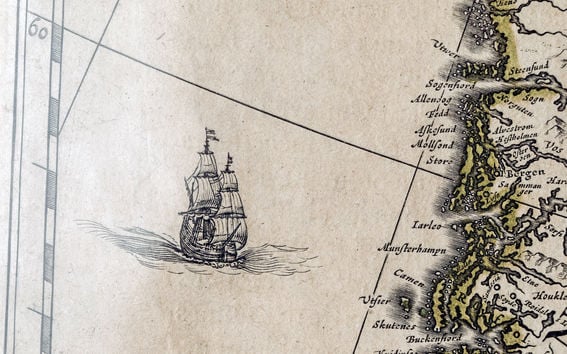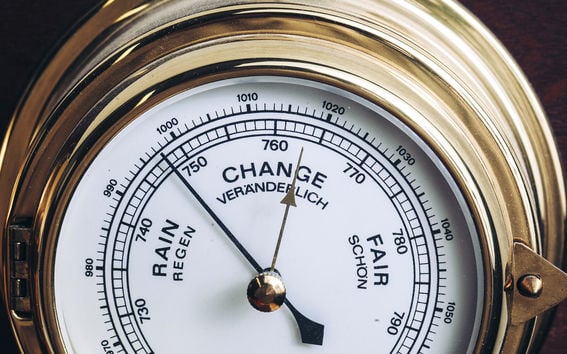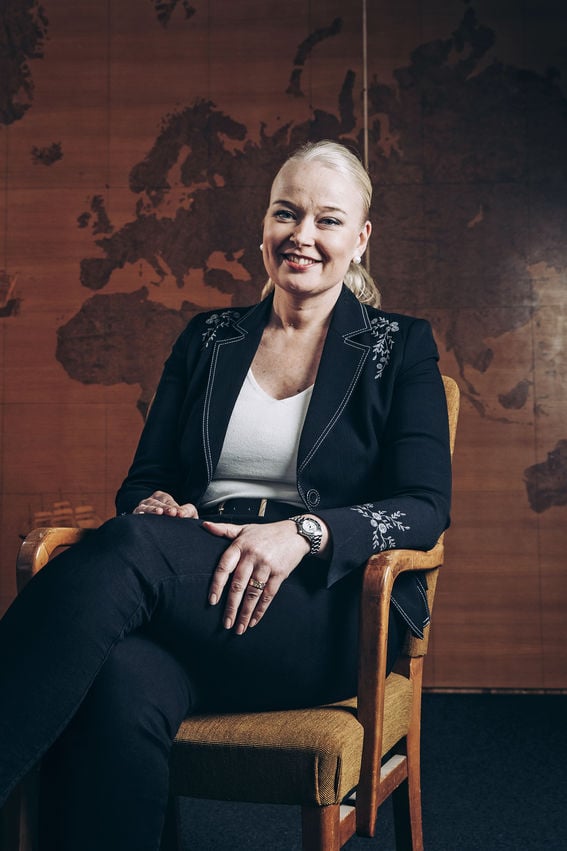For her beloved Baltic Sea

Some 90% of Finnish imports and exports rely on shipping. Should ships for one reason or another fail to leave port, the common saying Finland is an island would quickly become a reality.
‘Our national economy depends on seafaring. Sea traffic cannot be replaced in cargo transport, and it is also the soundest choice ecologically, says CEO Tiina Tuurnala.
It’s easy to see her career to date as a straightforward and logical procession.
Tuurnala, a student of location information technology and cartography at what was then the Helsinki University of Technology, first landed a summer job at the Finnish Maritime Administration. Less than a decade later, and still only 31, she was in charge of their marine survey division. From there, she was recruited to the Finnish Transport Agency, where she first worked as a Development Director before being promoted to Deputy Director General in charge of the traffic and information function. At the time, she was responsible for road, rail and maritime traffic functions at the Agency. About three years ago, she was called to the helm of the Finnish Shipowners’ Association.
Although the technology field was not Tuurnala’s only option, deciding to study map and location information technology was precisely the right choice. Back when she started her studies in the early 1990s, few would have guessed that location information would be used in so many applications. Nowadays, location information is associated with nearly every click we make on our computers. It is of interest to home appliance sellers and political decision-makers alike.
‘Being involved in precisely this phase of development, when electronic charts were introduced to maritime traffic, has been amazing. Digital location technology also changed the production processes of nautical charts and their means of production. Finland played a big role in the drafting of the international standard. I’ve always been comfortable on the bridge of a ship, and back then I spent lots of time there listening to feedback from seafarers on the development of chart technology,’ Tuurnala says.

Vital transports
Tiina Tuurnala represents an industry that employs about 12 000 people in Finland. The Association she heads has 26 member companies that operate more than 100 vessels engaged in international transports. Their eight-strong office on Helsinki’s Aleksanterinkatu lobbies officials and legislators to ensure that the needs of shipowners are taken into account in the drafting of national and international regulations. The Association also engages in comprehensive cooperation with maritime sector actors both domestically, within the EU and around the globe.
For its part, the national maritime cluster encompasses all of the sectors associated with maritime industry and it is truly vital to the economy, including things like shipbuilding, ports and transports. Strong cooperation is a prerequisite to the cluster’s efficient functioning. The Finnish maritime cluster employs more than 50 000 people and generates a turnover of some €13 billion.
‘The Finnish Shipowners’ Association is tasked with promoting the industry’s competitiveness, responsibility and comprehensive development. Digitalisation and automation have altered and will continue to alter also this sector radically,’ says Tuurnala.
Greener seafaring
As with all traffic, a crucial issue for seafaring is finding ways to improve its environment-friendliness. Minimising emissions is the key venture for the near future.
‘A lot has already been achieved, but there’s still plenty to do as well. Our goal is emission-free sea transports,’ Tuurnala says.
The International Maritime Organisation, a UN agency, has set the ambitious target to cut the carbon dioxide emissions of sea transports by 40% by 2030 and by 70% by 2050. The year of comparison is 2008 and the unit of measurement is one gram per transported tonne and kilometre.
‘Marine shipping operators report vessel-specific carbon dioxide emissions to the European Commission. Sea transport is the most environment-friendly alternative especially when hauling large cargo volumes – and often the only one, too. There’s frequently no option but to use marine transports,’ Tiina Tuurnala points out.
In the Northern European region, the sulphur emissions of sea transports have reduced to almost zero since 2015. That’s when the Sulphur Directive, which restricted sulphur emissions on the Baltic and the North Sea to 0.1%, came into force. A global 0.5% emission limit came into force at the start of the year.
The means for making seafaring more environment-friendly require new technology, enhanced energy-efficiency and hybrid solutions, which combine the use of different sources of energy. In future, more and more ships will be powered by, for example, liquefied natural gas, electricity or biofuel made from waste products. Sails will also be making a comeback to seafaring vessels as utilisation of wind energy increases. Finnish cargo ship Bore Estraden has for years been exploiting wind with the aid of a rotor sail. The Viking Grace also harnesses the wind.
‘So, many of these methods are already in use on ships owned by Finnish operators. Finnish ports and shipowners are at the forefront of development.’

Vulnerable Baltic
‘The sea has always been very dear to me,’ Tiina Tuurnala says.
‘I spent my childhood summers at a holiday cottage in the Kotka archipelago that my family still owns. I’d sit on the jetty angling deep into the night and stare out to sea. And I’d often take the boat out to go catch waves.’
The future of the Baltic Sea is very important to her. As an enclosed water area, it is vulnerable. It is also a shallow water body and challenging to navigate, as there is a lot of traffic. The most important task of traffic control is to prevent accidents.
‘Although there have been only a fewserious accidents, close calls have been more frequent. Good cooperation bet-ween Finnish officials and their counterparts in neighbouring countries has prevented many major accidents from happening.’
An oil spill, for example, would be disastrous for the Baltic.
Tireless efforts to ensure the safety of seafaring are ongoing on all shores of the Baltic Sea. In this, marine charting also plays an important role; chart information must be correct in order for navigation to be safe.
‘My respect for shipping professionals is unwavering. They keep calm through every storm and in any situation, and this never fails to impress me. This is why I’m always happy to visit the bridge whenever possible.’ •

Tiina Tuurnala
CEO of the Finnish Shipowners’ Association. Lives in Espoo.
Graduated with a Master of Science (Technology) in 1998, majoring in location information technology and cartography.
Named Aalto University School of Engineering Alumna of the Year 2019.
Is also
- Member of the Board at the Finnish Lifeboat Institution: ‘The work done by volunteer sea rescuers is extremely valuable. Should someone get into trouble when travelling over water, they get called to help.’
- Chairperson of the Maritime Transport Pool: ‘I’m engaged in maintaining Finland’s national emergency supply capabilities. Finland is entirely reliant on foreign trade, and maritime transports must flow also during a crisis.’
- Very patriotic: ‘I’ve been awarded the Finnish Defence Forces’ Medal for Military Merits and the Finnish Frontier Guard’s Cross of Merit.
I value these recognitions greatly, as I do the organisations behind them.’ - A horse-riding enthusiast: ‘I’ve been a rider since I was little and I’m delighted to ride with my 11-year-old daughter as company these days.’
Text: Leeni Peltonen
Photos: Aleksi Poutanen
This article is published in the Aalto University Magazine issue 26, April 2020.
- Published:
- Updated:
Read more news
Ashish Thapliyal: It’s amazing how small interactions can shape your career in unexpected ways
Ashish Thapliyal, a Doctoral Researcher at Aalto University, reflects on his unique educational journey and the valuable experiences he gained while studying at Aalto and Industrial Engineering and Management.
Appointments at the School of Chemical Engineering
The School of Chemical Engineering has appointed Jukka Hassinen as Development Manager and Sanna Hellstén as FinnCERES flagship Manager.
New technology brings immersive audio to everyone’s pockets
A new type of sound recording technology allows recording of immersive soundscapes with ordinary microphones and an inexpensive accessory